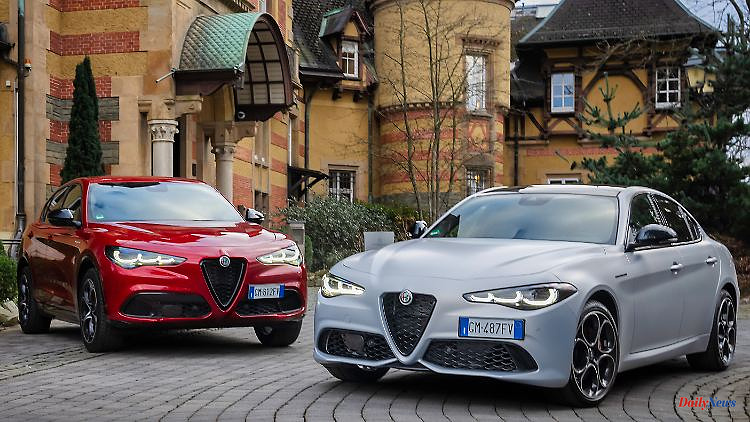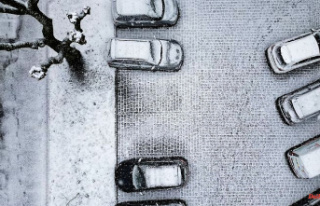The two mid-range models Alfa Romeo Giulia and Stelvio still have to hold out for a while before the Italian brand goes fully electric. ntv.de took a look at exactly what will be changed and once again took a seat behind the wheel of a Giulia Q4 with a petrol engine.
The first look at the price lists of the renovated versions of Alfa Romeo Giulia and Stelvio looks suspiciously like a clear cut: The 200 hp variant is thrown out, as are the versions with 280 hp and rear-wheel drive (all-wheel drive will be standard in the future). Even the weaker diesel with only one driven axle: history. Instead, diesel buyers now always get 210 hp and all-wheel drive. What's going on there? Quite simply, rarely accessed versions no longer have to be offered for sale.
In general, the second facelift of the now seven-year-old series is rather mild - it is particularly about sharpening the profile and replacing aging technical components until Alfa Romeo only wants to offer electrically powered vehicles in 2027 according to the current plan. But first things first.
Above all, a slightly preppy look with a modified front end and beautifully distinctive daytime running lights with three striking elements in the graphics - "Triple-U" in marketing slang - catch the eye. The Trilobo, known among the Alfisti (where else is there a technical term for fans of a car brand?), which is the triumvirate of the striking radiator grille, the Scudetto, and the two horizontal air intakes, is now presented in a more striking way. And the headlights are now available as standard in a high-tech guise as an adaptive matrix LED solution, while the old-fashioned bi-xenon spotlights are gone. The rear is adorned with modified taillights - colored darker and with a clear glass look.
How well the new light sources can really "shine around" pedestrians or oncoming traffic in practice, so as not to dazzle, remains to be seen in later test drives. The first contact with the refreshed Giulia takes place during the day. And despite the harsh sunlight on this cloudless day, the digits on the replaced instrument cluster are perfectly legible. This is where the second important innovation lies. Instead of mechanical displays, the instrumentation scales now consist purely of a display surface (12.3 inches).
However, the interior designers have found a solution that does not lose the fine style of the Alfa Romeo house. Instead of a screen carelessly slapped into the landscape, the chic look of a classic instrument unit remains, which also creates the visual impression of particularly deep instruments, as was the case with historical Alfa Romeo models. The "Heritage" mode also fits in with this - in this case the graphics of the surface (e.g. the font), which are also inspired by earlier brand representatives, correspond to the external appearance of the instrument module.
And of course there has to be a small test drive, even if the facelift is only slight. When you press the start button on the steering wheel, the four-cylinder engine of the sporty sedan wakes up. The acousticians have managed to train the two-liter to have a sporty, robust sound, although the typical Alfa sound has unfortunately been lost in the meantime. The 4.69 meter long and 1.6 ton 280 hp sedan is still fun to drive (if you want more utility, you have to use the Stelvio).
The direct injection engine, which is obligatorily coupled to the eight-stage ZF automatic converter, scores despite turbocharging with homogeneous power development and acts quite powerfully when the right pedal is used accordingly. Thanks to all-wheel drive that is now standard, lack of traction is not exactly one of the Italians' weaknesses. And the adaptive Q4 drive with variable power distribution, together with a 50:50 weight distribution, helps to take one or the other bend a bit more dynamically. If necessary, it only takes 150 milliseconds for the torque to move from the rear axle to the front tires (up to 50 percent).
Despite sporty approaches, the middle class is not a rock-solid chunk, but a balanced tourer thanks to an equally balanced chassis (in the "Competizione editions even with variable damping). High aluminum shares (80 percent) in the chassis components and even a cardan shaft made of carbon fiber Reminiscences of motor racing come up. And if you think such measures are a bit exaggerated given the level of performance: yes, dear Giulia Quadrifoglio fans, the passionate 510 hp top model is also available as a facelift version. A little patience please.
Of course, the Alfa dealer does not have to send diesel and utility fans home either. The latter have to choose Stelvio (similar modification measures as the sedan counterpart) instead of Giulia, because there will not be a classic station wagon. With a trunk volume of up to 1600 liters with the rear seat backs folded down, the SUV performs quite adequately in the transport sector - always bear in mind: this is a lifestyle product.
Incidentally, all versions of the modified Giulia and Stelvio are courting customers with active cruise control, which not only increases safety but also driving comfort. Because the vehicle brakes automatically in time with the flow of traffic. Simply set the speed and let it roll, but please always watch the traffic carefully, because assisted driving is not autonomous driving.
For an additional charge of 1750 euros, even more safety features are on board, including active lane keeping and blind spot assistants, motorway and traffic jam assistants plus traffic sign recognition.
In a price range of 54,250 to 70,150 euros, the Italian mid-range offers plenty of scope for equipment, customization and motorization. Navigation system, electric trunk lid (Stelvio), parking beeper, reversing camera, keyless locking system, smartphone integration to control Apple CarPlay or Android Auto and touchscreen in the center console in 8.8-inch format, however, are always standard.












